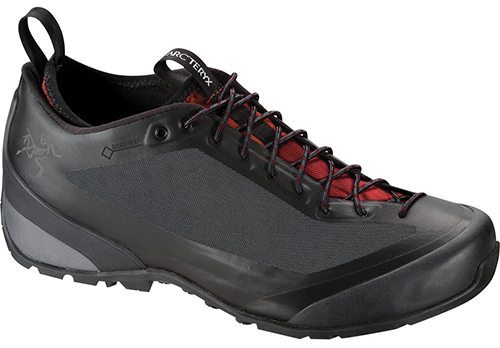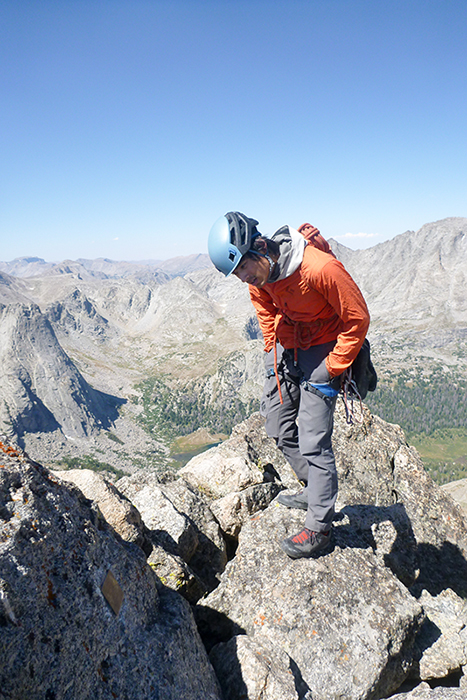
Arc’teryx Acrux FL GTX Approach Shoe
Stated Weight: 924 g
Size Tested: 42
MSRP: $230
Test Locations: Wind River Range, WY; RMNP, San Juan Mountains, CO
Days Tested: 30
[Note: I will refer to the shoes by their full name “Acrux FL GTX” throughout this review. Although it is a mouthful, Arc’teryx also sells a Acrux SL and Acrux FL (no GTX), so the distinction is important.]
Intro
Last year Arc’teryx made a big splash into the technical footwear market, taking their reputation for bombproof apparel and applying it to everything from trail runners to double-layer “super-gaiter” mountaineering boots. Somewhere in the middle of the spectrum falls the Acrux FL GTX approach shoe, a low-cut, waterproof, uninsulated shoe designed for long approaches and technical scrambling. After wearing them all over the Rockies, I found the shoes uniquely suited to certain niches of outdoor recreation, but found they walked an awkward balance between a lightweight approach shoe and a technical mountaineering boot.
Design
As with most Arc’teryx products, the Acrux FL GTX reflects a high level of craftsmanship and thoughtfulness in design. The entire Arc’teryx line of footwear is a bit of a departure from typical shoe construction, though. Rather than a leather or standard nylon/mesh upper, the Acrux FL GTX is constructed with a polyurethane-coated nylon fabric unlike anything I’ve seen on a pair of shoes before. The fabric is much stiffer than a normal shoe upper. Inside the outer shell is a sewn-in sock line inner shoe constructed of foam and mesh. Interestingly, the shoes do not have a traditional tongue, but rather the sock liner encompasses your whole foot. On the bottom, a Vibram sole akin to that seen on any other approach shoe rounds out the package.

Although I often consider function before form when passing judgement on a product, it’s worth noting that the Acrux FL GTX certainly make an outdoor fashion statement. Partly for fun, I asked the Outward Bound community to play a word association game with the shoes. Answers included, “lasers,” “Star Trek,” “boat shoes,” “office shoes,” “Sith Lord,” and surprisingly, “boots”. Suffice to say that the shoes are unique.
Fabric
Besides the aesthetic design, the fabric used in the shoes represents the single biggest departure from traditional shoes. Like I said, the shoes are constructed with a unique polyurethane (PU) -coated nylon fabric that is much stiffer than leather or mesh. I actually put a crease in the toe box as a result of kneeling down (more on that later). The PU fabric holds its shape much more than a traditional shoe, and the stiffness of the fabric contributes to its durability, as well. After multiple backcountry trips including off-trail talus travel and lots of 4th- and low 5th-class scrambling, I have not been able to put any significant scuffs or holes in the shoes. Although I would like to see how they hold up to multiple seasons of use, the Acrux FL GTX is one of the more durable approach shoes I’ve worn.
Fit and Break-In
I have a very oddly shaped foot; wide toes, flat arch, narrow heel. I often have trouble finding technical footwear that is wide enough for my forefoot without needing to size up and get a shoe that’s longer as well. For this reason, I tend to stick with a particular style of shoe once I find one that fits well.
The Acrux FL GTX has laces that go nearly all the way down to the end of the toe box, allowing a great range of adjustment along the length of the shoe. I was able to loosen the toe box sufficiently to keep my feet comfortable and still lock down my heel to prevent any heel lift. That said, I did need to play with the laces significantly more than on a leather shoe because the stiffness of the upper fabric does not respond well to micro adjustment. It took wearing the shoes on the 7-mile trail to Warbonnet Peak in the Wind River Range before I felt like the toe box even began to open up and break-in.
Even now after wearing the shoes for two months, I do not think I have broken them in fully. The upper fabric is incredibly stiff and resilient and the very nature of it that makes it so durable also makes the shoes very uncomfortable for much longer than a comparable pair of leather approach shoes. For example, the crease that developed along the toe box from kneeling down is still in the shoes and pushes painfully into the top of my toe joints when I walk around.
Waterproofing
Like I would expect, the Gore-Tex insert in the Acrux FL GTX does an adequate job of keeping my feet dry so long as they’re not totally immersed in water. On a recent Outward Bound course we received sideways rain, snow, sleet, and hail for four days in a row in the San Juan Mountains and my feet stayed dry for the first two days even when hiking along the Continental Divide, completely exposed to the elements. By the third day, the shoes were waterlogged and my feet got wet just like everyone else’s, but I was happy at how long it took for the shoes to soak through.
Unsurprisingly though, the beefy waterproof liner also made my feet sweat more than an unlined shoe in warm conditions. Much like wearing a hard shell on a sunny day, my feet got very sweaty and I actually was able to wring out my socks when hiking into the Wind Rivers on a hot, bluebird day.
Performance
If you’re starting to think I have mixed feelings about the Acrux FL GTX, you are spot on. While the shoes are innovative and are potentially a great alternative to traditional approach shoes, they fall short in several areas that make them less than ideal in most situations.
The biggest issue for me with the shoes is the awkward balance between stiffness and nimbleness. The Acrux FL GTX are the stiffest approach shoe I’ve ever worn which makes them great for walking with a heavy pack, or attempting to kick steps in late summer snowfields. However I think the stiffness is negated by the fact that the shoes do not break in easily, and even once broken in, have a larger profile than a shoe like the Five Ten Guide Tennie or the Scarpa Crux. The larger profile, especially in the toe box, makes the Acrux FL GTX difficult to scramble low 5th class terrain in part due to the lack of sensitivity. In this way, the Acrux FL GTX is closer to a 3/4 shank mountain boot like the La Sportiva Trango or the Scarpa Triolet than an approach shoe.
At the same time, the Acrux FL GTX is not a mountain boot and should not be considered a viable alternative on terrain where crampons and kicked steps are a necessity. As such, I did not find much mountain terrain where I felt the Acrux FL GTX truly shone. More often than not I found myself cursing the shoes and wishing I had either something lighter and more sensitive, or heavier and stiffer. I thought the Acrux FL GTX was too heavy and clunky to be a true approach shoe, but not stiff enough to replace a mountain boot. For the sake of comparison, I felt comfortable and confident on the North Ridge of the Grand Teton (5.8+) with a 30 lbs pack on while wearing my old pair of Scarpa Crux’s, but was uncertain and less comfortable on the West Ridge of Pagoda Mt (5.7) with no pack on while wearing the Acrux FL GTX.

While in the Wind Rivers this summer, I actually hiked back to the trailhead on a climbing rest day and switched my shoes back to my old trail runners because I was so disenchanted with the performance of the Acrux FL GTX. Not only did my feet revolt after hiking in the Acrux FL GTX and begin to blister from overheating, the shoes are also significantly heavier than most other popular approach shoes (compare the stated weight of 924 g to the Scarpa Crux at 788 g or the Five Ten Guide Tennie at 820 g). This made the Acrux FL GTX more of a hassle to carry on long multi-pitch routes.
The only time I was really happy I was wearing the Acrux FL GTX was when working a very cold, wet, and windy backpacking course in the San Juans. Since we were on trail, I was happy to not have a full ankle boot, but was also glad to have something waterproof and a bit more supportive than just a trail-running shoe. Admittedly though, this is a very specific niche that I really liked the shoes in, and not one that I normally find myself in.
Bottom Line
The Arc’teryx Acrux FL GTX is a radical departure from a traditional approach shoe, and while I appreciate the innovation and forward thinking that Arc’teryx put into the shoe, I think it represents a solution without a problem. Arc’teryx shot for the moon in trying to combine a mountain boot and an approach shoe into a single piece of footwear, and while I think they missed on this particular piece, I think it’s also worth keeping in mind that NASA didn’t send just one Apollo mission.

Excellent review from the perspective of a climber and moutaineer! The verdict is spot on. Having a perfect fit in these shoes I came to the same conclusion.There should be more quality reviews like this in the net.
Thanks for the feedback Jack! That’s exactly what we’re trying to do – no BS, just real-life testing on humans.
Was about to purchase them from AT’s website of ReGear on sale. Glad i didn’t.
I’m looking for a light backpacking shoe (not boot) for semi-technical terrain w/ a <10kg pack. Have you any reccomendations? :)
Las acabo de compartir y creo que se sienten muy bien pero las voy a probar ya veremos.